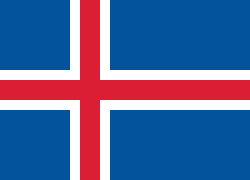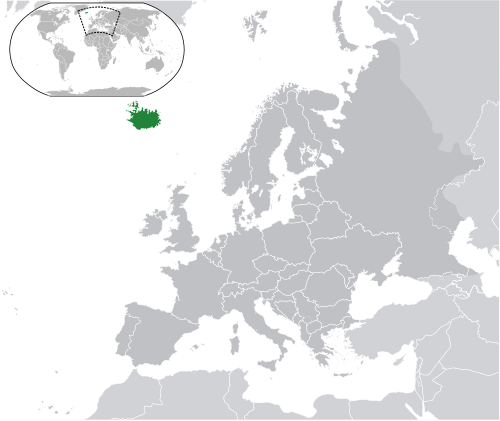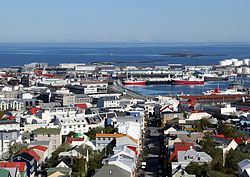Iceland
Iceland (Icelandic: [Ísland] Error: {{Lang}}: text has italic markup (help); [ˈistlant] (![]() listen)) is an island country in the North Atlantic, between Greenland and Norway, formerly a possession of Denmark. It is culturally considered to be part of Europe. Iceland is 301 kilometers east of Greenland and 1001 kilometers west of Norway. There are about 329,100 people who live in Iceland. Iceland has an area of 103,000 km².
listen)) is an island country in the North Atlantic, between Greenland and Norway, formerly a possession of Denmark. It is culturally considered to be part of Europe. Iceland is 301 kilometers east of Greenland and 1001 kilometers west of Norway. There are about 329,100 people who live in Iceland. Iceland has an area of 103,000 km².
Iceland Ísland | |
|---|---|
| Anthem: | |
| Capital and largest city | Reykjavík 64°08′N 21°56′W / 64.133°N 21.933°W |
| Official languages | Icelandic |
| Ethnic groups |
|
| Religion (2020)[3] | 75.1% Christianity —63.5% Church of Iceland[b] —7.6% Other Protestant —4.0% Roman Catholic 21.5% No religion 1.3% Ásatrúarfélagið 2.1% Other |
| Demonym(s) | Icelander Icelandic |
| Government | Unitary parliamentary republic |
| Guðni Th. Jóhannesson | |
| Katrín Jakobsdóttir | |
| Steingrímur J. Sigfússon | |
| Þorgeir Örlygsson | |
| Legislature | Althing |
| Formation | |
| 9th century | |
| 930–1262 | |
| 1262–1397 | |
| 1397–1523 | |
| 1523–1814 | |
| 14 January 1814 | |
| 5 January 1874 | |
• Extended home rule | 1 February 1904 |
| 1 December 1918 | |
• Republic | 17 June 1944 |
| 3 May 1960 | |
| Area | |
• Total | 102,775[4] km2 (39,682 sq mi) (106th) |
• Water (%) | 2.07 (as of 2015)[5] |
| Population | |
• 2020 estimate | 364,134 (179th) |
• 2011 census | 315,556[6] |
• Density | 3.5/km2 (9.1/sq mi) (190th) |
| GDP (PPP) | 2020 estimate |
• Total | $19.8 billion[7] (142nd) |
• Per capita | $54,482[7] (16th) |
| GDP (nominal) | 2020 estimate |
• Total | $20.8 billion[7] |
• Per capita | $57,189[7] (5th) |
| Gini (2016) | ▼ 24.1[8] low · 2nd |
| HDI (2019) | very high · 4th |
| Currency | Icelandic króna (ISK) |
| Time zone | UTC[c] (GMT/WET) |
| Date format | dd/mm/yyyy |
| Driving side | right |
| Calling code | +354 |
| ISO 3166 code | IS |
| Internet TLD | .is |
History
The first people who lived on Iceland are thought to have been Irish monks. They came to Iceland around the year 800.
Iceland became a Christian nation in the year 1000 CE, when Christianity became the religion by law. In Icelandic, this event is known as the kristnitaka literally, "the taking of Christianity".
In the 9th century, Norsemen went to live in Iceland. The first Norseman who lived in Iceland was Flóki Vilgerðarson. He was also the one who gave Iceland its name. Ingólfur Arnarsons was the first permanent settler on the island.[12] This chieftain from Norway went to live in South West Iceland and founded the city of Reykjavík.
In 930, the Icelandic rulers wrote a constitution. They created the Althing, a kind of parliament in a place called Þingvellir. Therefore, Iceland is the oldest existing republic.
In 985, Erik the Red was sent away from the island because he had killed someone. He sailed to the west and discovered Greenland. Eric's son Leif Ericson discovered America in the year 1000. He called it Vinland. The voyages of Eric, Leif and others were written down in the sagas (long stories).
In 1262, Iceland became part of Norway. This lasted for 400 years. In 1662, it became part of Denmark. In the 19th century, many Icelandic's wanted to be independent from Denmark. In 1918, Iceland got many powers of its own, but the king of Denmark was still king of Iceland.
When Germany took over Denmark on April 9 1940, the Althing decided that Icelandic’s should rule the country themselves, but they did not declare independence yet. British and later American soldiers occupied Iceland to prevent it from being attacked by the Germans. In 1944, Iceland finally became fully independent.
After World War II, Iceland became a member of the North Atlantic Treaty Organization (NATO), but not of the European Union. Between 1958 and 1976, there were three debates between Iceland and the United Kingdom about the rights to catch codfish. They were called the Cod Wars.
In 1980, Vigdís Finnbogadóttir was elected president of Iceland. She was the first woman ever to be elected president of a country.
In 2016, Guðni Th. Jóhannesson become president of Iceland.
Politics
Iceland has a multi-party system. Since the 2013 election, the center-right Independence Party and Progressive Party are the biggest political parties in Iceland. Other powerful parties in Iceland include the center-left Social Democratic Alliance and Left-Green Movement. See also: List of political parties in Iceland.
Iceland is a representative democracy and a parliamentary republic. Iceland has a president (Guðni Th. Jóhannesson[13]) and a prime minister (Katrín Jakobsdóttir). The parliament, Althing, has 63 members and each member can only be in there for four years.[14] The president is elected by Icelanders, and is in government for four years. The president can be elected an unlimited amount of times.
Iceland has no standing army. The United States Air Force had a base near Reykjanesbær, but they left in 2006. Since 2008, NATO nations have occasionally had their air force patrol Iceland. This was requested by the Icelandic government.[15][16]
Divisions
Iceland is divided into 8 regions, 6 constituencies and 74 municipalities (since 2013). The regions are mainly used for statistics. The constituencies are used for selecting politicians who will represent them in parliament. Lastly, the municipalities give services to the people that live there. These services include education, waste management, public transportation, and so on.
Before 2003, the constituencies were the same as regions, but this was changed because it meant that a vote in Reykjavik meant less than one in a rural area. Even though this was addressed, the problem still exists.[17]
Economy
Fishing and fish processing is the main economic activity in Iceland.[18] Despite effort to diversify, particularly into the travel industry, seafood exports continue to account for nearly three-quarters of merchandise exports and approximately half of all foreign exchange earnings.
Geothermal Energy produces the vast majority of Electrical Power consumed on Iceland, due chiefly to the island's position atop the Mid-Atlantic Ridge and exhibits plentiful hot water reservoirs and geysers. This has the effect of drastically reducing the price of electricity in Iceland, and has attracted several energy-intensive industries.
Aluminum Smelting (The reduction of Aluminum ores to Aluminum metal) is the largest energy-intensive manufacturing sector in Iceland, and the country produced over 800,000 Metric Tonnes per Year in 2013,[19] making it the 10th largest producer of Aluminum metal worldwide.
Geography
Iceland sits on a rift between two tectonic plates. No surprise then that Iceland is very geologically active.
There are large amounts of rain and snow caused by the warm waters of the gulf stream current which flows toward it. Many interesting and unusual geographic features which make it different from any other island.
Some of these features are Iceland's numerous mountains, volcanoes, hot springs, rivers, small lakes, waterfalls, glaciers, and geysers. The word geyser is, in fact, derived from Geysir, the name of a particularly famous geyser on the southern side of the island. Glaciers cover about 11% of the island and the largest, Vatnajökull, is up to 1 km thick and, by far, the largest glacier in Europe.
Iceland, though a European country, sits partly in North America since it straddles the Mid-Atlantic Ridge which marks the boundary between the Eurasian and North American tectonic plates. The ridge runs right through the populated Reykjavik and Thingvellir historic areas. The tectonic activity of these plates separating is the source of the abundant geothermal energy in the region.
Towns and cities
Reykjavík is the capital city of Iceland. Reykjavík is also the most important port in Iceland. Other important towns in Iceland are Akureyri, Kópavogur, Hafnarfjörður, Keflavík, Seyðisfjörður and Vestmannaeyjar.
People
If you see a group of Icelanders together, one thing will immediately strike you. They all look rather similar. This impression is even stronger if you see an age-group of children together. And, they are indeed genetically more similar than any other group in any other European country. The reason is that they had a small founding population, and a very modest rate of immigration after that.
This is a problem which their government is well aware of. Why should it be a problem? Because it increases the risk that a viral infection could sweep through the whole population. So they have a very good health service which is entirely funded by the government. It is a world without Down's syndrome. Why? Because all pregnant women are tested, and any foetus with a serious genetic defect is aborted.[20]
The people in Iceland are mostly of Scandinavian origin. The language they speak is Icelandic. The language has not changed much in 1,000 years, so Icelanders are still able to read the sagas about the Vikings without many problems. Most people in Iceland are Christian. Most of them are Lutheran.
Icelandic people are considered to be the happiest people on Earth.[21] Iceland has the highest birth rate in Europe, highest divorce rate and the highest percentage of women working outside their home.[21]
Names
There are no real surnames on Iceland. Children get the first name of their father (sometimes mother) with -s+son if it's a boy, and -s+dóttir if it's a girl. For example, a man named Jón Stefánsson has a son named Fjalar. Fjalar's last name will not be Stefánsson like his father's, it will become Fjalar Jónsson. The same goes for women. Jón Stefánsson's daughter Kata would not have the last name Stefánsson, she would have the name Jónsdóttir. In most countries people use to call other people by their surname, but in Iceland people call other people by their first name. So when people talk about Halldór Ásgrímsson they do not call him Ásgrímsson, but Halldór.
Iceland Media
National anthem of Iceland; composed in 1874. An instrumental recording, performed by the United States Navy Band.
Norsemen landing in Iceland – a 19th-century depiction by Oscar Wergeland
Ingólfr Arnarson (modern Icelandic: Ingólfur Arnarson), the first permanent Scandinavian settler
Ósvör, a replica of an old fishing outpost outside Bolungarvík
HMS Berwick led the British invasion of Iceland.
British warship HMS Scylla (right) collides with Icelandic cost guard vessel ICGV Óðinn in the Atlantic Ocean during the Third Cod War
Notes
- ↑ By country of citizenship
- ↑ The Constitution of Iceland confirms the Church of Iceland as the state church of Iceland.[2]
- ↑ Iceland uses UTC with no offset year round and has not observed daylight saving time since 1968.[10] Since Iceland is much farther west than England, the Reykjavík local mean time (the time when the sun is the highest) is offset from the observed time by around 90 minutes.[11]
References
- ↑ "Population by country of citizenship, sex and age (2018)". Statistics Iceland. Retrieved 6 May 2019.[dead link]
- ↑ Constitution of the Republic of Iceland: Article 62, Government of Iceland.
- ↑ "PX-Web - Select variable and values". Archived from the original on 2021-01-28. Retrieved 2021-01-14.
- ↑ "Ísland er minna en talið var" (in íslenska). RÚV. 26 February 2015. Archived from the original on 15 March 2015. Retrieved 10 March 2015.
- ↑ "Surface water and surface water change". Organisation for Economic Co-operation and Development (OECD). Retrieved 2020-10-11.
- ↑ "Census 2011 - Main results". www.statice.is. Statistics Iceland. 1 January 2020. Retrieved 27 May 2020.
- ↑ 7.0 7.1 7.2 7.3 "Iceland". International Monetary Fund.
- ↑ "Gini coefficient of equivalised disposable income – EU-SILC survey". ec.europa.eu. Eurostat. Retrieved 7 March 2019.
- ↑ Human Development Report 2020 The Next Frontier: Human Development and the Anthropocene (PDF). United Nations Development Programme. 15 December 2020. pp. 343–346. ISBN 978-92-1-126442-5. Retrieved 16 December 2020.
- ↑ Emilía Dagný Sveinbjörnsdóttir (2008). "Hvenær var hætt að skipta á milli sumar- og vetrartíma á Íslandi?" (in íslenska). Vísindavefurinn. Archived from the original on 12 November 2018. Retrieved 7 November 2019.
- ↑ "Tillaga til þingsályktunar um seinkun klukkunnar og bjartari morgna" (in íslenska). Althing. 2014. Archived from the original on 7 November 2019. Retrieved 7 November 2019.
- ↑ Tomasson, Richard F. (1980). Iceland, the first new society. U of Minnesota Press. p. 63. ISBN 978-0-8166-0913-0.
- ↑ Ansari, Azadeh; Hume, Tim. "Iceland elects first new president in 20 years". cnn.com (CNN). http://www.cnn.com/2016/06/26/world/iceland-president-gudni-johannesson/. Retrieved 2 August 2016.
- ↑ "Government & Politics". Iceland.is. Archived from the original on 18 January 2010. Retrieved 10 February 2010.
- ↑ "French Air Force in Iceland". Ministry for Foreign Affairs. 5 May 2008. Retrieved 2 October 2010.
- ↑ "Air Policing". NATO Air Command Operations. Retrieved 2 October 2010.
- ↑ "Iceland". The World Factbook. Central Intelligence Agency. Archived from the original on 18 May 2020. Retrieved 6 August 2006.
- ↑ "Iceland economy". Archived from the original on June 25, 2013. Retrieved December 16, 2013.
- ↑ Hjalti Jóhannesson. "Aluminium overtakes fish in Iceland". Nordregio website. Archived from the original on 30 March 2017. Retrieved 10 August 2014.
- ↑ Gee, Alison (29 September 2016). "A world without Down's syndrome?". BBC News. Archived from the original on 2 January 2017. [1]
- ↑ 21.0 21.1 "No wonder Iceland has the happiest people on earth". The Guardian.com. 18 May 2008. Retrieved September 24, 2013.
Other websites
- CIA World Factbook information about Iceland
- Iceland at the Open Directory Project
- Wikimedia Atlas of Iceland














